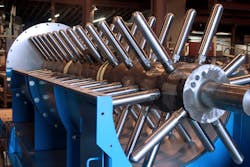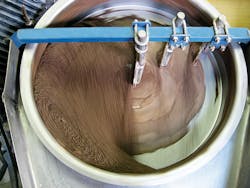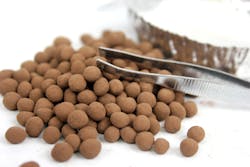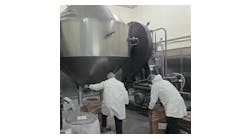Agitation agglomeration: Engineering particles for the chemical industry
Agitation agglomeration has long been employed by the chemical processing industry as a way to manage the dust associated with bulk solids. But as products become more specialized and markets more demanding, this approach to particle size enlargement is becoming more widespread for a different reason: In addition to the ability to mitigate dust, agitation agglomeration also gives manufacturers particle engineering capabilities, offering a high level of control over particle characteristics that go beyond basic parameters.
What follows is a look at how agitation agglomeration gives chemical processors the tools to manufacture their products to meet increasingly specific market expectations.
What is agitation agglomeration?
Agitation agglomeration is just one form of agglomeration, or particle size enlargement. While other approaches utilize heat or pressure to form a granular product, agitation agglomeration employs agitation or motion, along with a liquid binder, to form granules or pellets.
Granule formation occurs because fines are made tacky by the addition of the liquid binder, which, when paired with agitation, causes fines to aggregate together into a loose form that densifies as it tumbles. Along with the continuous feed of additional fines and binder, granules collect additional layers, which are refined through the tumbling motion.
This layering effect, known as coalescence, is similar to rolling a snowball and forms the basis of the agitation agglomeration technique.
This type of agglomeration may also be called wet granulation, tumble-growth agglomeration, pelletizing, balling or non-pressure agglomeration.
Agitation agglomeration equipment types
Agitation agglomeration can be carried out using one or a combination of several types of equipment, each offering unique opportunities for customization to optimize how the equipment works with the specific material to be processed to yield the desired particle characteristics.
The devices available are as follows:
Granulation drum: Also known as an agglomeration drum, agglomerator or granulator, the granulation drum is a rotary drum equipped with an internal spray system for binder distribution. The rotating drum uses a rolling and tumbling motion to encourage granule formation and layering.
The granulation drum produces rounded granules that are fairly uniform in size and shape, and can range in size from 1 mm to 25+ mm.
Pugmill mixer: Also known as a paddle mixer or pug mill, the pugmill mixer is a horizontal mixer equipped with two counter-rotating shafts fitted with angled paddles inside a u-shaped trough. The design imparts a kneading and folding action on material.
The pugmill mixer produces a conditioned mixture from solid and liquid feed components and yields rough agglomerates of varying sizes.
Pin mixer: Also a horizontal mixer, the pin mixer consists of a single shaft fitted with strategically placed rods that impart an intense spinning action on material within the mixer’s cylindrical trough.
The pin mixer is capable of producing a homogeneous mixture of solid and liquid feed components, as well as dense pellets, uniform in shape and size. When used to produce agglomerates, the resulting pellets are typically in the size range of 20-60 mesh (but can be somewhat larger in special applications), which may be referred to as “micro pellets.”
Disc pelletizer: Also known as a pan granulator, the disc pelletizer is perhaps the most recognized device in the category. The disc pelletizer consists of a rotating pan that uses centrifugal force to promote granule formation and growth.
The disc pelletizer can yield pellets uniform in size and shape, in the range of 35 mesh to 1/2" (0.5 mm to 14 mm).
As can be seen, each type of equipment is unique and offers a slightly different mode of action to encourage granule formation and coalescence. These units can be used as standalone agglomeration devices, or in combination to strategically employ the strengths of each type, giving chemical processors ample opportunity to manage particle characteristics.
Particle characteristics: Critical at every step
Whether preparing an intermediate product for a downstream production process, producing a finished product for market or simply managing transportation costs, the ability to control particle characteristics is essential at every step in the lifecycle of chemical products.
Control over particle characteristics allows chemical processors to ensure that their products look, handle and perform exactly as intended. Further, agitation agglomeration is also a valuable tool in recovering lost resources in the form of dust that would otherwise be unusable. Baghouse fines, for example, can be collected and agglomerated for reintroduction into the process.
A prime example of the importance of particle characteristics throughout a product’s lifecycle lies in the production of fertilizers.
As an intermediate product, control over particle characteristics allows the manufacturer to not only manage shipping costs, but also to ensure that the fertilizer transfers cleanly and with minimal waste at transfer points, and that product integrity will be maintained during any times of storage.
Moreover, if the product will be blended with other nutrients to produce a compound fertilizer, the ability to control particle characteristics allows the producer to maximize flowability so the product is easily and accurately metered into the blending process.
In bringing a finished fertilizer to market, a manufacturer must be able to reliably produce a consistent product that meets the various requirements expected, such as size, shape, crush strength, composition and more.
Basic particle characteristics
The specifications important in any given setting vary by industry sub-sector, and even by product. The most basic parameters that can be controlled through the agitation agglomeration process include:
- Particle size distribution (PSD)
- Crush strength
- Compression strength
- Bulk density
- Chemical composition
- Uniformity (UI and SGN)
- Moisture content
- Green/Wet strength
- Particle shape
- Surface quality
- Porosity
Advanced particle characteristics
The ability to control these basic parameters lends further control over more advanced qualities; by manipulating basic particle characteristics, chemical producers can also then control:
- Attrition
- Flowability
- Dissolution/Solubility
- Surface-area-to-volume ratio
- Melting capabilities
- Segregation
- Bed permeability (for liquid or gaseous flow)
- Potential for caking
- Accuracy of application
- Product look, feel and perception
- Potential for inhalation hazards
- Coating capabilities
- Control over active ingredient delivery/release
- Rate of reaction
- Packing density
Process parameters used to control particle characteristics
The agitation agglomeration process, as well as the equipment it employs, offers numerous opportunities for influencing particle characteristics. The extent of adjustment capabilities differs depending on the chosen equipment configuration, but overall, the following process parameters are collaboratively applied to control the characteristics of the product.
Note: It’s important to recognize that each parameter listed below may be applied or operate slightly differently based on the type of equipment.
Retention time
Retention time, also known as residence time, refers to the amount of time a material resides in the processing device.
In general, a longer retention time translates to larger agglomerates, up to the point at which agglomerates reach the maximum allowable size for the given process parameters (at which point they may begin to break down).
In the pin mixer and pugmill mixer, retention time is also used to control whether agglomerates form; a shorter retention time can be employed to simply produce a homogeneous mixture of the solid and liquid feeds without the formation of agglomerates, though the potential for agglomerate formation also depends on managing several material characteristics as well.
Spray nozzle type and location
A wide variety of spray nozzle types are available on the market to suit various process needs. Spray nozzles can be designed to trickle the liquid binder into the process, or fully atomize the spray for maximum distribution of the binder in low quantities, and everything in between.
Nozzle type, as well as the number and location of spray points in the unit, significantly influences exactly how and where granule formation occurs. One might think that the spray system design could be the same across the same type of equipment, but this is not the case; spray nozzle type and location is a highly customized aspect of design for each application. This is because these factors depend on the characteristics of the material being processed and how it responds to agglomeration, as well as the specific processing goals.
Spray location is especially critical when it comes to proper disc pelletizer operation. For example, a heavy stream of binder sprayed onto the disc pelletizer may cause the material to take on a mud-like consistency incongruent with granule formation. Likewise, it could allow for granule formation, but cause clumps of pellets (known as “raspberries”) to form, ultimately yielding off-spec product.
Binder and feed rates
Similarly, the rate at which the binder is applied, in conjunction with the rate of feedstock entering the unit, also significantly influences particle characteristics. Binder addition must take into account the amount of moisture in the starting feedstock. In most cases, it is desirable to reach the maximum moisture level permitted for the product gradually.
For example, if the rate of binder addition is too high at the inlet, the material might form into large clumps, inhibiting proper granule formation. But if the binder is added in gradual and controlled increments, granule formation and growth can occur.
RPMs/speed
Equipment speed also ties heavily into granule properties. In general, the faster the agitation, the more dense granules will be (up to a point). Depending on the equipment and the material characteristics, however, a speed that is too high could also prevent granules from forming and/or growing, as the unit may simply carry particles around causing them to become more dense without allowing them to collect additional binder and fines for growth.
In a pugmill mixer, shaft rotational speed is used to “throw” the material into the air, exposing as much material as possible to the atomized spray.
Equipment-specific parameters
Each piece of equipment offers its own unique set of adjustments that allow for control over granule characteristics, the most important of which typically revolves around the level and specific action of agitation.
In the pin mixer, the pin design (full or half sweep) and arrangement are used to create the desired motion. Similarly, in the pugmill mixer, the number, placement and pitch of paddles are used to control the specific motion occurring inside the trough.
In the granulation drum, tumbling flights may be installed to increase the amount of agitation occurring in the material bed.
The disc pelletizer allows for adjustment of disc angle (in addition to disc speed) to control the level of centrifugal force occurring on the disc. Scrapers and plows are also employed to assist in classification of pellets, and manage the layer of buildup on the disc.
Operators use these factors in combination with retention time, speed, binder and feed rates, as well as spray location and method, to influence granule properties.
The pin mixer-disc pelletizer process: The height of granule control and refinement
The combination of a pin mixer and disc pelletizer offers chemical producers the highest level of control over granule properties and produces a highly refined product. As such, this setup is one of the most common approaches to producing a granular product via agitation agglomeration.
In this configuration, the pin mixer serves as a preconditioning device, combining the solid and liquid feedstocks into a homogeneous mixture, and often forming “seed pellets” or starting nuclei onto which layers of material can then be added using the disc pelletizer. Retention time and speed are used to control the density of seed pellets.
The disc pelletizer receives the seed pellets, and through the continuous addition of fines and binder, creates the layering or coalescence that grows granules to the desired size. Once granules reach the desired size, they are automatically discharged from the disc via centrifugal force and the continuous addition of new material.
This combination of equipment gives producers ample opportunity to control and refine granule qualities by adjusting parameters such as:
- Pin mixer speed and retention time
- Pin design and placement
- Binder and feed rates (in the pin mixer and disc pelletizer)
- Spray rate, location and nozzle type (in the pin mixer and disc pelletizer)
- Disc pelletizer speed and angle
- Disc pelletizer scraper and plow locations
Because many of these variables are adjustable in real time, operators can respond to changes in production to maintain a consistent product output despite fluctuation.
The level of control provided by this approach is also favored by chemical producers because it gives them the ability to optimize the amount of on-size product coming off the line at any given time.
Conclusion
While agitation agglomeration was initially developed as a means to control dust, the flexibility of the agitation agglomeration technique, and the control it gives producers over particle engineering, has caused it to become an increasingly widespread approach to particle size enlargement.
By adjusting process variables such as retention time, spray system design, speed and more, chemical producers have the opportunity to control the more advanced aspects of their product, engineering particles to improve downstream processing, bring a product to market or manage shipping costs.
The diversity of the technique, however, combined with the numerous variables present, makes thorough test work essential in building a commercial-scale process that efficiently agglomerates material according to specification.
Chris Kozicki is a Process Sales Engineer specializing in tumble-growth agglomeration and has been with FEECO for over 30 years. Chris is an active member of the agglomeration community and former president of the Institute for Briquetting and Agglomeration (IBA).
Carrie Carlson is a technical writer who has been with FEECO for over a decade. She works closely with engineers and process experts to turn complex ideas into easy-to-understand literature.
FEECO International





